Displaying items by tag: Irish Dinghy Racing Association
This weekend’s two-day All-Ireland Sailing Championship at the National Yacht Club in Dun Laoghaire, racing boats of the ISA J/80 SailFleet flotilla, is an easy target for facile criticism. Perhaps because it tries to do so much in the space of only two days racing, with just one type of boat and an entry of 15 class championship-winning helms, inevitably this means it will be seen by some as falling short of its high aspiration of providing a true Champion of Champions.
Yet it seldom fails to produce an absolute cracker of a final. Last year, current defending champion Anthony O’Leary of Cork, racing the J/80s in Howth and representing both ICRA Class 0 and the 1720 Sportsboats, snatched a last gasp win from 2013 title-holder Ben Duncan of the SB20s, thereby rounding out an utterly exceptional personal season for O’Leary which saw him go on to be very deservedly declared the Afloat.ie “Sailor of the Year” 2014.
So this year, with a host of younger challengers drawn from a remarkable variety of sailing backgrounds, the ever-youthful Anthony O’Leary might well see himself in the position of the Senior Stag defending his territory against half a dozen young bucks who will seem to attack him from several directions. And with winds forecast to increase in strength as the weekend progresses, differing talents and varying levels of athletic ability will hope to experience their preferred conditions at some stage, thereby getting that extra bit of confidence to bring success within their reach. It’s a fascinating scenario, and W M Nixon tries to set this unique event in perspective.
When the founding fathers of modern dinghy racing in Ireland set up the Irish Dinghy Racing Association (now the ISA) in 1946, they would have been reasonably confident that the immediate success of their new pillar event, the Helmsman’s Championship of Ireland, gave hope that a contest of this stature would still be healthily in being, and still run on a keenly-followed annual basis, nearly seventy years later.
They might even have been able to envisage that it would have been re-named the All-Ireland Championship, even if their original title of Helmsman’s Championship had a totally unique and clearly recognisable quality, for they’d have accepted its fairly harmless gender bias was going to create increasing friction with the Politically Correct brigade.
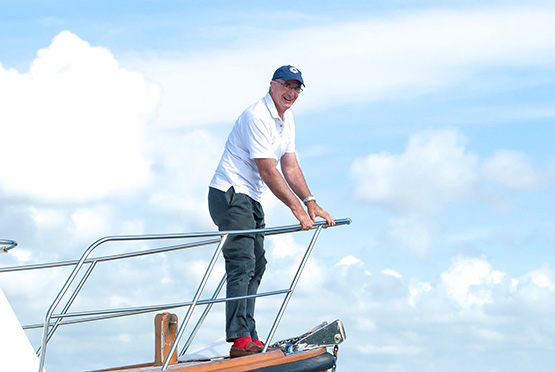 The Stag at Bay? Anthony O’leary sniffs the breeze last weekend, in charge of racing in the CH Marine Autumn league. This weekend he defends his All-Ireland title in Dun Laoghaire. Photo: Robert Bateman
The Stag at Bay? Anthony O’leary sniffs the breeze last weekend, in charge of racing in the CH Marine Autumn league. This weekend he defends his All-Ireland title in Dun Laoghaire. Photo: Robert Bateman
 Sailing should be fun, and run with courtesy – invitation to enjoyable racing, as displayed last weekend in Cork on Anthony O’Leary’s Committee Boat. Photo: Robert Bateman
Sailing should be fun, and run with courtesy – invitation to enjoyable racing, as displayed last weekend in Cork on Anthony O’Leary’s Committee Boat. Photo: Robert Bateman
But what those pioneering performance dinghy racers in 1946 can scarcely have imagined was that, 69 years later, no less than a quarter of the coveted places in the All-Ireland Championship lineup of 16 sailing stars would be going to helms who have qualified through winning their classes within the Annual National Championship of a thirteen-year-old all-Ireland body known as the Irish Cruiser-Racing Association.
And if you then further informed those great men and women of 1946 that those titles were all won in an absolute humdinger of a four-day big-fleet national championship staged in the thriving sailing centre and Irish gourmet capital of Kinsale, they’d have doubted your sanity. For in the late 1940s, Kinsale had slipped almost totally under the national sailing radar, while the town generally was showing such signs of terminal decline that there was little enough in the way of resources to put any food on any table, let alone think in terms of destination restaurants.
So in tracing the history of this uniquely Irish championship (for it long pre-dates the Endeavour Trophy in England), we have a convenient structure to hold together a manageable narrative of the story of Irish sailboat racing since the end of World War II. Add in the listings of the Irish Cruising Club trophies since the first one was instituted in 1931, then cross-reference this info with such records as the winners of the Round Ireland race and the Dun Laoghaire to Dingle Race, beef it all up with the winners of the national championship of the largest dinghy and inshore keelboat classes, and a comprehensible narrative of our national sailing history emerges.
 The veteran X332 Equinox (Ross McDonald) continues to be a force in Irish cruiser-racing, and by winning her class in the ICRA Nationals in Kinsale at the end of June, Equinox is represented in the All Irelands this weekend by helmsman Simon Rattigan. Photo: W M Nixon
The veteran X332 Equinox (Ross McDonald) continues to be a force in Irish cruiser-racing, and by winning her class in the ICRA Nationals in Kinsale at the end of June, Equinox is represented in the All Irelands this weekend by helmsman Simon Rattigan. Photo: W M Nixon
It’s far from perfect, but it’s a defining picture nevertheless, even if it lacks the inside story of the clubs. Be that as it may, in looking at it properly, we get a greater realization that the All-Ireland Helmsman’s Championship (or whatever you’re having yourself) is something very important, something to be cherished and nurtured from year to year.
Of course I’m not suggesting that we should all be out in Dublin Bay today and tomorrow on spectator boats, avidly watching every twist and turn as eight identical boats race their hearts out with a variety of helms calling the shots. Unless you’re in a particular helmsperson’s fan club, it’s really rather boring to watch from end to end, or at least until the conclusion of each stage and then the final races.
This is very much a sport for the “edited highlights”. The reality is that no matter how they try to jazz it up, sailing is primarily of interest only to those actively taking part, or directly engaged in staging each event. When great efforts are made to make it exciting for casual spectators, it costs several mints and results in rich people and highly-resourced teams engaged in costly and often unseemly battles to which genuine sporting sailors cannot really relate at all.
But with its exclusion of Olympic and some High Performance squad members, the All-Ireland in its current form is the quintessence of Irish local and national sailing. It’s almost compulsive for its participants, it provides an extra interest for their supportive clubmates, and in its pleasantly low key way it’s a genuine expression of real Irish sailing, the sailing of L’Irlande profonde.
So of course we agree that it might be more interesting for the bright young people if it was raced in something more trendy like the RS400s if they could find sufficient owners to risk their boats in this particular bear pit. And yes indeed, the ISA Discussion Paper and Helmsmans Guidelines of 2012 did indeed hope that within three years, the All Ireland would be staged in dinghies.
But we have to live in the real world. Sailing really is a sport for life, and some of our best sailors are truly seniors who would be disadvantaged if it was raced in a boat making too many demands on sheer athleticism, for which the unattainable Olympic Finn would be the only true answer.
But in any case, if you watch J/80s racing in a breeze, there’s no doubting the advantage a bit of athletic ability confers, yet the cunning seniors can overcome their lack of suppleness and agility with sheer sailing genius.
 While they may be keelboats, in a breeze the J/80s will sail better with some athleticism, as displayed here by Ben Duncan (second left) as he sweeps toward the finish and victory in the 2013 All Irelands at Howth. Photo: Aidan Tarbett
While they may be keelboats, in a breeze the J/80s will sail better with some athleticism, as displayed here by Ben Duncan (second left) as he sweeps toward the finish and victory in the 2013 All Irelands at Howth. Photo: Aidan Tarbett
 Yet a spot of sailing genius can offset the adverse effects of advancing years – Anthony O’Leary (right) with Dylan Gannon (left) and Dan O’Grady after snatching victory at the last minute in 2014. Photo: Jonathan Wormald.
Yet a spot of sailing genius can offset the adverse effects of advancing years – Anthony O’Leary (right) with Dylan Gannon (left) and Dan O’Grady after snatching victory at the last minute in 2014. Photo: Jonathan Wormald.
But another reality we have to accept is that Ireland is only just crawling out of the Great Recession. And in that recession, it was the enduring competitiveness of ageing cruiser-racers and the sporting attitude of their owners which kept the national sailing show on the road. Your dyed-in-the-wool dinghy sailor may sneer at the constrictions of seaborn truck-racing. But young sailors who were realists very quickly grasped that if they wanted to get regular sailing with good competition as the Irish economy went into free fall, then they had to hone their skills in making boats with lids, crewed by tough old birds most emphatically not in the first flush of youth, sail very well indeed.
Thus in providing a way for impecunious young people to keep sailing through the recession, ICRA performs a great service for Irish sailing. And the productive interaction between young and old in the ICRA fleets, further enlivened by their different sailing backgrounds, has resulted in a vibrant new type of sailing community where it is regarded as healthily normal to be able to move between dinghies and keelboats and back again.
The final lineup of entries is a remarkable overview of the current Irish racing scene, and if you wonder why the winner of the GP14 British Opens 2015, Shane McCarthy of Greystones, is not representing the GP 14s, the word is he’s unavailable, so his place is taken by Niall Henry of Sligo.
2014 Champion Anthony O'Leary, RCYC
RS400 Alex Barry, Monkstown Bay SC
GP14 Niall Henry ,Sligo Yacht Club
Shannon OD Frank Browne, Lough Ree YC
Flying Fifteen David Gorman, National YC
Squib Fergus O'Kelly, Howth YC
ICRA 1 Roy Darrer, Waterford Sailing Club
Mermaid Patrick, Dillon Rush SC
Laser Std Ronan Cull, Howth YC
SB20 Michael O'Connor, Royal St.George YC
IDRA14 Alan Henry, Sutton DC
RS200 Frank O'Rourke, Greystones SC
ICRA 2 Simon Rattigan, Howth YC
ICRA 4 Cillian Dickson, Howth YC
Ruffian Chris Helme, Royal St.George YC
As a three-person boat with a semi-sportsboat performance, the J/80 is a reasonable compromise between dinghies and keelboats, and the class has the reputation of being fun to sail, which is exactly what’s needed here.
The Sailing Olympics and the ISAF Worlds may be terribly important events for sailing in the international context, but nobody would claim they’re fun events. Equally, though, you wouldn’t dream of suggesting the All-Ireland is no more than a fun event. But it strikes that neat balance between tough sport and sailing enjoyment to make it quite a good expression of the true Irish amateur sailing scene.
Inevitably from time to time it produces a champion whose sailing abilities are so exceptional that it would amount to a betrayal of their personal potential for them not to go professional in some way or other. But fortunately sailing is such a diverse world that two of the outstanding winners of the Helmsman’s Championships of Ireland have managed to make their fulfilled careers as top level professional sailors without losing that magic sense of fun and enjoyment, even though in both cases it has involved leaving Ireland.
Their wins were gained in the classic early Irish Yachting Association scenario of a one design class which functioned on a local basis being able to provide enough reasonably-matched boats to be used for the Helmsman’s, and the three I best remember were when Gordon Maguire won in 1982 on Lough Derg racing Shannon One Designs, then in the 1970s Harold Cudmore won on Lough Neagh racing Flying Fifteens, and in 1970 itself, a very young Robert Dix was winner racing National 18s at Crosshaven.
Gordon Maguire was the classic case of a talented sailor having to get out of Ireland to fulfill himself. His win in 1982 in breezy conditions at Dromineer in Shannon One Designs, with Dave Cummins of Sutton on the mainsheet, was sport at its best, though I doubt that some of the old SODs were ever the better again after the hard driving they received.
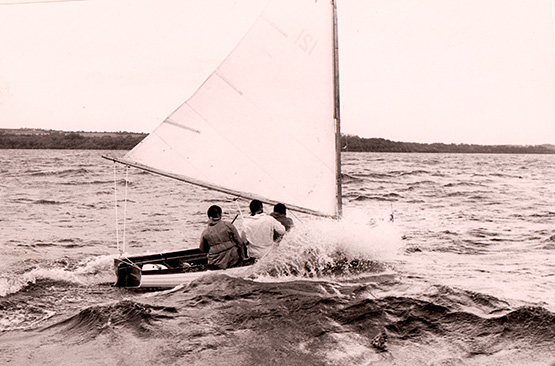 Driving force. Gordon Maguire going indecently fast for a Shannon One Design, on his way to winning the Helmsmans Championship of Ireland at Dromineer in 1982. Photo: W M Nixon
Driving force. Gordon Maguire going indecently fast for a Shannon One Design, on his way to winning the Helmsmans Championship of Ireland at Dromineer in 1982. Photo: W M Nixon
Then Gordon spread his wings, and won the Irish Windsurfer Nationals in 1984 - a great year for the Maguires, as his father Neville (himself a winner of the Helmsmans Championship five times) won the ISORA Championship with his Club Shamrock Demelza the same weekend.
But Gordon needed a larger canvas to demonstrate his talents, and in 1991 he was a member of the Irish Southern Cross team in Australia, a series which culminated in the Sydney-Hobart Race. The boat which Maguire was sailing was knocked out in a collision with another boat (it was the other boat’s fault), but Maguire found a new berth as lead helm on the boat Harold Cudmore was skippering for the Hobart Race, and they won that overall.
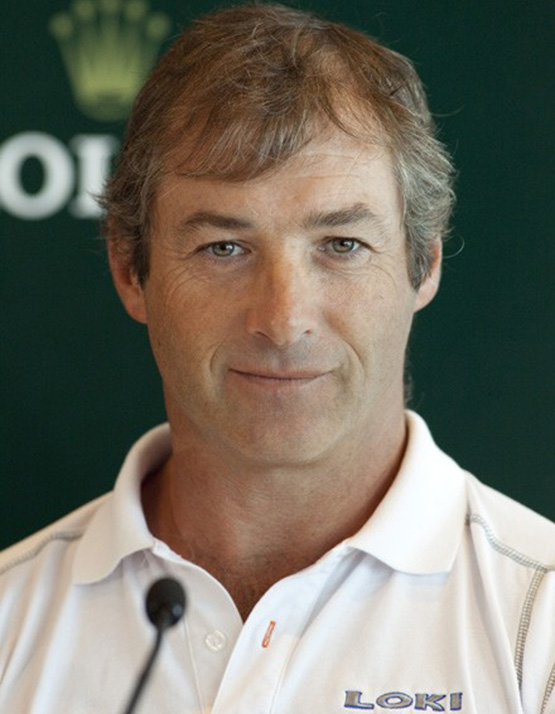 A man fulfilled, Gordon Maguire at the beginning of his hugely successful linkup with Stephen Ainsworth’s RP 63 Loki
A man fulfilled, Gordon Maguire at the beginning of his hugely successful linkup with Stephen Ainsworth’s RP 63 Loki
And Gordon Magure realized that for his talents, Australia was the place to be. More than twenty years later, he was to get his second Hobart Race overall win in command of Stephen Ainsworth’s RP 63 Loki, and here indeed was a man fulfilled, revelling in a chosen career which would have been unimaginable in Ireland.
Harold Cudmore had gone professional as best he could in 1974, but it was often a lonely and frustrating road in Europe. However, his win of the Half Ton Worlds in Trieste in the Ron Holland-designed, Killian Bushe-built Silver Shamrock in 1976 put his name up in lights, and he has been there ever since, renowned for his ability to make any boat perform to her best. It has been said of him when racing the 19 Metre Mariquita in the lightest conditions, that you could feel him getting an extra ounce of speed out of this big and demanding gaff-rigged classic seemingly by sheer silent will power.
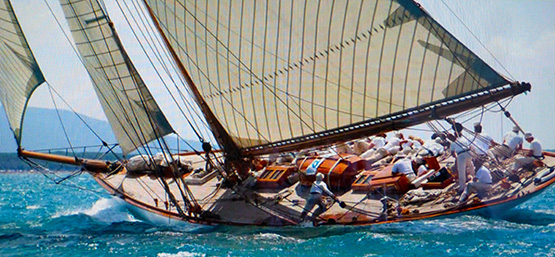
The restored 19 Metre Mariquita is a demanding beast to sail in any conditions…

...but in light airs, Harold Cudmore (standing centre) seems to be able to get her to outsail larger craft by sheer will-power.
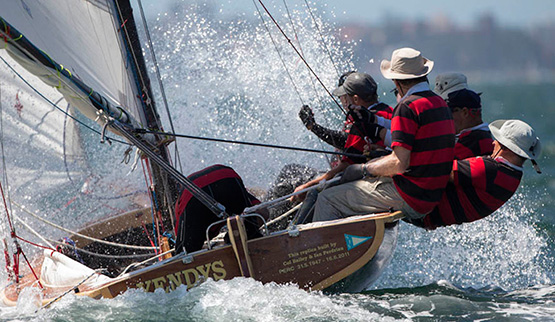 A different scene altogether, but still great sport – Harold Cudmore racing the classic Sydney Harbour 18-footer Yendys
A different scene altogether, but still great sport – Harold Cudmore racing the classic Sydney Harbour 18-footer Yendys
But as for Robert Dix’s fabulous win in 1970, while he went on to represent Ireland in the 1976 Olympics in Canada, he has remained a top amateur sailor who is also resolutely grounded in Irish business life (albeit at a rather stratospheric level). But then it could be argued that nothing could ever be better than winning the Helmsmans Championship of Ireland against the cream of Irish sailng when you’re just 17 years old, and doing it all at the mother club, the Royal Cork, as it celebrated its Quarter Millenium.
It was exactly 44 years ago, the weekend of October 3rd-4th 1970, and for Robert Dix it was a family thing, as his brother-in-law Richard Burrows was Number 2 in the three-man setup. They were on a roll, and how. The manner in which things were going their way was shown in an early race when they were in a tacking duel with Harold Cudmore. Coming to the weather mark, Cudmore crossed them on port, but the Dix team had read it to such perfection that by the time he had tacked, they’d shot through the gap with inches to spare and Cudmore couldn’t catch them thereafter.

Decisive moment in the 1970 Helmsman’s Championship. At the weather mark, Harold Cudmore on port is just able to cross Robert Dix on starboard………Photo W M Nixon
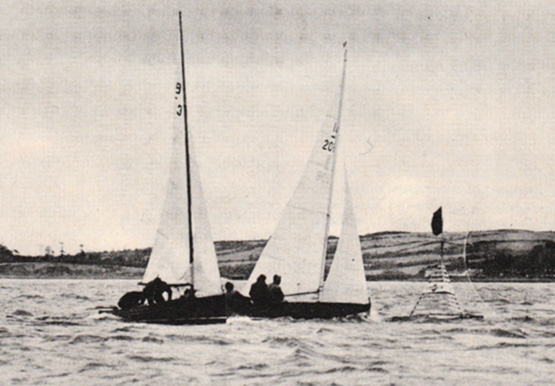 ……but Dix is able to shoot through the gap as Cudmore tacks…..Photo: W M Nixon
……but Dix is able to shoot through the gap as Cudmore tacks…..Photo: W M Nixon
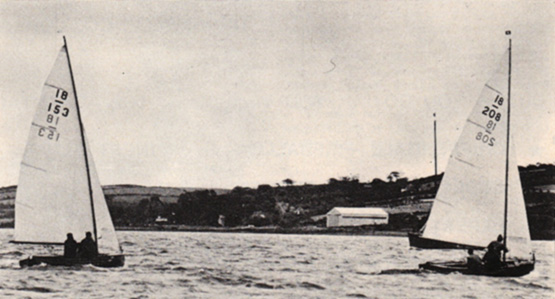 …..and is on his way to a win which will count well towards his overall victory over Cudmore by 0.4 points. Photo: W M Nixon
…..and is on his way to a win which will count well towards his overall victory over Cudmore by 0.4 points. Photo: W M Nixon
Admittedly both Harold Cudmore and the equally-renowned Somers Payne had gear problems, but even allowing for that, the 17-year-old Robert Dix from Malahide was the star of the show, and the final points of Robert Dix 9.5 and Harold Cudmore 9.9 for the 1970 Helmsman’s Championship of Ireland says it all, and it says it as clearly now as it did then.
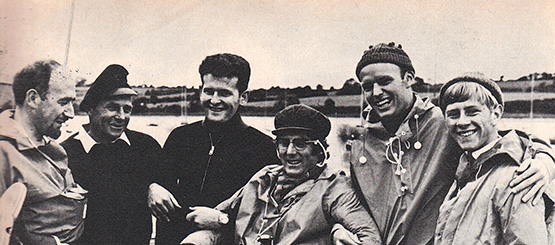
The six finalists in the 1970 Helmsman’s Championship were (left to right) Michael O’Rahilly Dun Laoghaire), Somers Payne (Cork), Harold Cudmore (Cork), Owen Delany (Dun Laoghaire), Maurice Butler (Ballyholme, champion 1969) and Robert Dix (Malahide), at 17 the youngest title holder ever. Photo: W M Nixon





























































